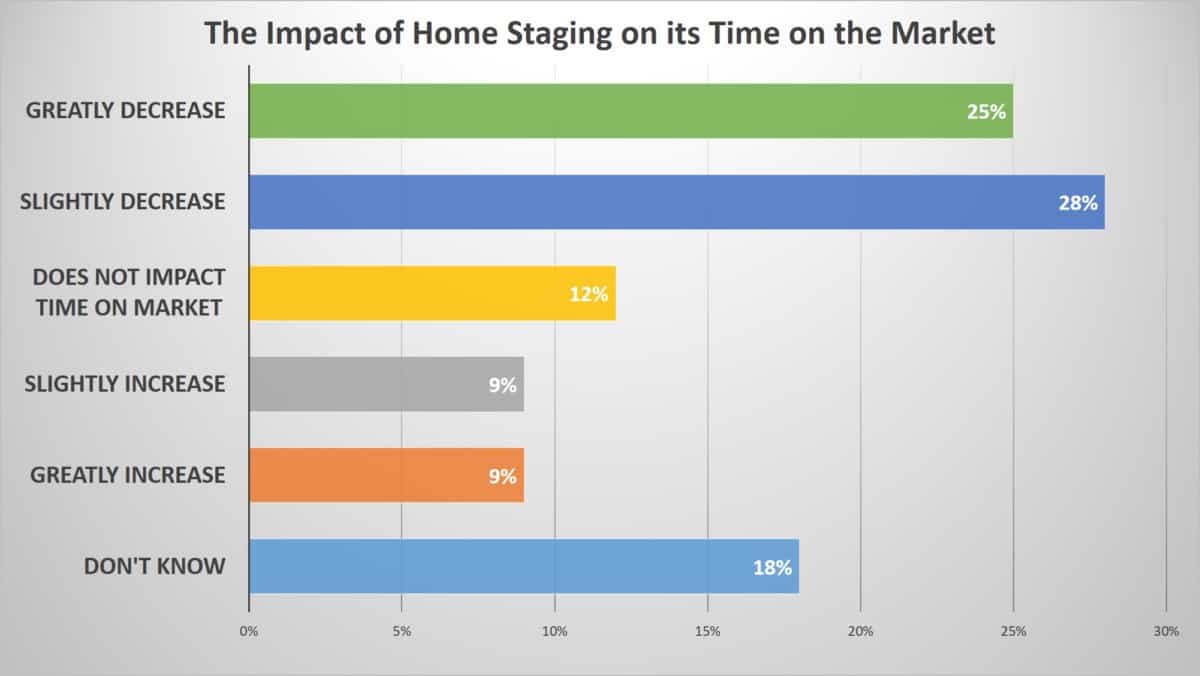(**) Disclosure: This post may contain affiliate links, meaning our company, JCHQ Publishing will get a commission if you decide to make a purchase through the links, but at no additional cost to you.
Selling a home fast can be a rollercoaster ride of emotions. The stress of a property not finding a buyer, the worry of getting a good deal, and the constant push to get everything just right – these are hurdles that both real estate agents and homeowners face.
But selling a home isn’t just about selling a property; it’s about selling a feeling. This is where the superpower of home staging comes in- creating a feeling that makes buyers fall in love.
That’s why we’ve put together this easy-to-follow guide on how to stage a home for a quick sale. Whether you’re a pro agent aiming to win client trust or someone new to the selling game, we’re here to help.
To stage a home for swift sale, meticulous decluttering, strategic furniture arrangement, and cultivating a warm, inviting atmosphere are pivotal.
Let’s jump into this journey together, getting where you’re coming from and giving you the tools to master the art of staging for a quick and successful sale.
Understanding the Magic of Staging

Source: NAR 2019 Profile of Home Staging
How Buyers Think: We all want a place to call our own, a space where we can see ourselves living life. Staging does this by setting up a scene that makes buyers feel all warm and fuzzy inside. It’s more than just how things look; it’s about helping buyers see their dreams coming true in your space. Staging turns a plain old house into a home that pulls at heartstrings.
Faster Sales: If you’re a real estate agent, you know how nerve-wracking it is when a property just sits there. The longer it’s unsold, the more it can mess with your mojo and the whole selling process. This is where staging comes to save the day. A well-staged home grabs attention fast and leaves a lasting impression. It stands out in a sea of listings, catching the eye of buyers who are itching to say “sold!” Staging isn’t just about looks; it’s about giving your property an edge.
According to The National Association of REALTOR 2019 Profile of Home Staging, a staged home could sell faster, with a value increase of 5% to 20%.
Here’s another post you could be interested: Does Staging a Home Help it Sells? (Facts Revealed)
Getting Ready for the Spotlight
Now that we’ve connected on the shared joys and jitters of selling, let’s roll up our sleeves and get into action. Think of your property as a star preparing for its big show – it needs to look its absolute best. Here’s your roadmap to getting ready for the spotlight.
The Three-Step Prep: Clean, Repair, Upgrade: Imagine inviting guests over and realizing your place needs some sprucing up. It’s the same with staging. Start by giving your home a thorough cleaning, making it shine from top to bottom. Fix those leaky faucets and creaky doors, making sure everything’s in tip-top shape. And while major renovations might not be on the agenda, small upgrades like fresh paint or updated fixtures can give your place a modern touch.
Curb Appeal: Making a Great First Impression: You know how important first impressions are, right? The same goes for your property. The outside matters as much as the inside. Trim that overgrown hedge, add a fresh coat of paint to the front door, and make sure the entryway welcomes with open arms. Remember, potential buyers often decide whether they’re interested in a home within seconds of seeing it. Let’s make those seconds count.
 (**)
(**)Decluttering and Depersonalizing for Buyer Love
Alright, let’s talk about the nitty-gritty of staging. You know that feeling when you tidy up your room before guests arrive? It’s the same principle here, just on a bigger scale. Decluttering and depersonalizing are your secret weapons to make buyers fall head over heels for your property.
Streamlining Spaces for Visual Appeal: You’ve got a beautiful space – let’s make sure everyone sees it. Remove excess stuff that’s hiding your home’s true potential. Clutter can make rooms feel cramped and overwhelming, so get rid of what you don’t need. Open spaces create an inviting vibe that potential buyers can’t resist.
Allowing Buyers to Envision Themselves: Your property’s like a blank canvas, and buyers need to imagine their lives painted on it. This means tucking away personal items like family photos and quirky knick-knacks. When buyers walk in, they should instantly see themselves living there. It’s all about creating a neutral space that’s ready for new stories.
The 3 Foot-5 Foot Rule: Finding the Perfect Balance: Imagine walking into a room and feeling like you can’t move because of all the furniture. That’s where the 3 Foot-5 Foot Rule comes in. Keep furniture at least 3 feet away from the walls to create a cozy vibe. And make sure there’s at least 5 feet of open space between furniture pieces. This creates a flow that makes the room feel bigger and more welcoming.

A Palette of Colors and the Magic of Lighting
Welcome to the world of colors and lighting – two elements that can completely transform the mood of a space. Just like picking the right outfit for a special occasion, choosing the right colors and lighting can set the perfect stage for your property’s showcase.
Choosing a Neutral Color Palette: When it comes to colors, neutrality is your best friend. Soft, neutral tones create a canvas that’s easy on the eyes and allows buyers to envision their own style. Think calming beiges, warm grays, and soft whites. These colors make your property a blank slate, ready for new beginnings.
Lighting: The Ambiance Creator: Lighting isn’t just about brightness; it’s about setting the mood. Make sure each room has a mix of ambient lighting (soft, overall illumination), task lighting (focused light for specific tasks), and accent lighting (to highlight features like artwork). A well-lit room feels inviting and cheerful, creating an instant connection with potential buyers.
Adding Pops of Color for Visual Interest: While neutrals are the base, a pop of color here and there can add life to your space. Think colorful throw pillows, vibrant artwork, or even a bold rug. These accents inject personality into your property without overwhelming the senses. Remember, it’s all about balance – too much color can be distracting.
Furniture Arrangement and Creating Focal Points
Let’s dive into the heart of staging – furniture arrangement and creating focal points. Think of your property as a story waiting to be told, and furniture and focal points are the characters that bring it to life.
Selecting Appropriate Furniture: Choosing the right furniture is like casting the perfect actors for a play. Each room has a purpose, so make sure your furniture matches that purpose. Avoid oversized pieces that can overwhelm a space. Opt for furniture that fits comfortably and leaves enough room to move around.
Arranging Furniture for Optimal Flow: Ever walked into a room and felt like you were navigating an obstacle course? That’s not the vibe we’re going for. Arrange furniture to create natural pathways that guide buyers through the space. This helps them visualize how they’ll move around and use the room in their daily lives.
Creating Focal Points that Wow: Every room has a star – a feature that deserves the spotlight. It could be a stunning fireplace, a breathtaking view, or a unique architectural detail. Arrange furniture to draw attention to these features. Let the focal point be the hero of the room, captivating potential buyers the moment they walk in.

Final Touches and the Art of Ambiance
As we approach the final stretch of our staging journey, let’s talk about the finishing touches that add that extra dash of magic. Just like adding a pinch of spice to a recipe, these elements elevate your property from good to unforgettable.
Thoughtful Decorative Elements: Accessorizing is like adding jewelry to an outfit – it completes the look. Use decorative items like vases, candles, and tasteful artwork to enhance the visual appeal of your space. But remember, less is more. A few carefully chosen pieces can make a stronger impact than an overload of decor.
Bringing the Outdoors In: Plants and greenery breathe life into any space. They add a touch of nature that creates a sense of freshness and vitality. Place potted plants in corners, on tables, or near windows. They not only look appealing but also contribute to a more relaxed and inviting atmosphere.
Scent and Sound: Appealing to the Senses: Creating a sensory experience is the secret sauce of staging. Use subtle scents like freshly baked cookies or a gentle floral aroma to create a comforting ambiance. Soft, relaxing background music can also set the mood, making potential buyers feel at ease and right at home.
From the basics of preparing your property to these final touches, we’ve covered every step of staging that leads to success. Your home is now transformed into a space that resonates with potential buyers on a personal level. As you master these techniques, you’re ready to make a lasting impact in the real estate market.
Virtual Staging and the Digital Advantage
In our ever-evolving digital world, virtual staging emerges as a valuable tool for sellers, especially when dealing with empty homes. Picture a digital makeover that transforms vacant rooms into fully furnished, inviting spaces – all without moving a single piece of furniture.
Benefits of Virtual Staging for Empty Properties: Virtual staging breathes life into empty spaces, helping buyers visualize the potential of each room. Online listings with virtually staged images stand out, capturing attention and engaging potential buyers. This modern approach offers cost-effective solutions that cater to a tech-savvy audience.
Check out the post: AI Virtual Staging an Entire House in Under 10 Minutes
Collaborating with Professionals for Authenticity: While virtual staging offers numerous advantages, collaborating with professionals ensures authenticity. Skilled designers blend virtual elements seamlessly with reality, creating a visual representation that resonates with buyers’ emotions. A balanced approach strikes a chord between creativity and accuracy.
Photography and Marketing: The Final Act of Staging: The art of staging reaches its zenith with high-quality photography and strategic marketing. Capturing the essence of staged rooms through professional photography elevates your property’s appeal. Incorporating these images into marketing materials and online listings creates an irresistible package that entices potential buyers.
Expert Staging Tips from a Leading San Francisco Home Stager (Video)
I came across the above video from Heather Lin, a REALTOR from Keller Williams Realty. In this clip, she interviewed Emily Vesely, a top home stager in the San Francisco Peninsula and Silicon Valley.
Below are some key takeaways I got from the video:
- Importance of Staging: Staging a home is essential, especially in competitive real estate markets like San Francisco and Silicon Valley. Well-staged homes stand out, attract more attention from potential buyers, and enhance the overall appeal.
- Online Presentation: Most potential buyers begin their search online, emphasizing the significance of high-quality listing photos. Proper staging helps homes look their best in online images, making them more likely to catch the viewer’s eye.
- Use of Mirrors: Mirrors are used to create the illusion of space and reflect light, particularly in smaller rooms. This technique can help open up the area and make it feel more inviting.
- Strategic Rug Placement: Rugs play a role in defining spaces within an open layout, making each area feel distinct and cozy. Choosing the right size of rug for the space is crucial to maintaining proper proportions.
- Layering and Accessories: Layering a space involves adding decorative elements like pillows, accessories, and art to bring color and texture. This enhances the visual appeal and makes the home feel warm and lived-in.
- Furniture Scale: Ensuring that furniture is appropriately scaled for the room is important. Properly sized furniture creates a balanced and inviting environment.
- Utilizing Unusual Spaces: Unconventional areas can be creatively repurposed. For example, an open space can be transformed into a breakfast nook, reading corner, or workspace, enhancing the home’s functionality.
- Addressing Concerns: The video addresses potential viewer concerns, such as having clutter due to kids’ toys. It hints at an additional video with easy and affordable home improvement ideas to get a home ready for sale.
One idea I like from the video is the strategic use of mirrors and rugs to the importance of properly scaled furniture.
Conclusion: Navigating the Path to Success
Staging a home for a quick sale transcends arranging furniture; it’s about orchestrating a symphony that resonates with potential buyers. By understanding their aspirations, addressing their concerns, and creating spaces that evoke emotions, you’re on the path to success.
Armed with expert insights, you’re equipped to navigate the intricacies of staging, turning each property into a desirable canvas where buyers envision their future. So, as you step into the world of real estate, remember that staging isn’t just a technique – it’s a story waiting to be told, one that leads to swift sales and satisfied hearts.
As part of the requirement to stay in good standing with the Licensing Commission, you must complete the required Continuing Education. The Colibri is an online school that I like and received excellent feedback from its students. You may check out their CE courses here. (**)
(**) Affiliate Disclosure: Please note that some of the links above are affiliate links, and at no additional cost to you. Our company, JCHQ Publishing will earn a commission if you decide to make a purchase after clicking on the link. Please understand that we include them based on our experience or the research on these companies or products, and we recommend them because they are helpful and useful, not because of the small commissions we make if you decide to buy something through the links. Please do not spend any money on these products unless you feel you need them or that they will help you achieve your goals.
Disclaimer: The information in this post is for general information only, and not intend to provide any advice. They are subjected to change without any notice, and not guaranteed to be error-free. Some of the posts on this site may contain views and opinions from individual not related to JCHQ Publishing. They do not necessarily reflect our view or position.


